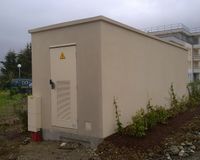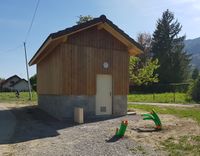Tag:telecom=exchange
| Description |
|---|
| A place to connect landlines subscribers to telecommunication service equipments |
| Group: telecom |
| Used on these elements |
| Useful combination |
| Status: approved |
| Tools for this tag |
|
An Exchange (722-06-05) is a place (i.e physically a building or a cabinet) containing several services equipments including telecom switches, transmission and amplification equipment, main and/or secondary distribution frames. It connects local loops (subscribers side) to backbone and long distance networks.
Tagging
A telephone exchange is a building, a part of a building or in some countries a street cabinet which connects a subscriber's home with the service provider devices. A lot of switching equipments are located in exchanges, including the Main Distribution Frame which is actually inside the building (and shouldn't be confused with the real building). This document means that exchanges can be hosted in street cabinets for sake of space savings, which doesn't imply that all telecom street cabinets are actual exchanges. Especially connection points shouldn't be confused with real telecom exchanges.
| Key | Value | Description | Use |
|---|---|---|---|
| telecom | exchange | The exchange building should be mapped as |
mandatory |
| building | service | Combined with the building, When located in a dedicated building. | optional |
| building:prefabricated | yes | When the building is prefabricated | optional |
| man_made | street_cabinet | Combined with the cabinet, When the telephone exchange is in a street cabinet. | optional |
| utility | telecom | The building or the cabinet is dedicated to telecommunications activity. Not necessary when mapped as a dedicated node inside a wider building | recommended |
| telecom:medium | <medium type> | The type of local loop it is used to. See below for possible values. | recommended |
| operator operator:wikidata |
<operator> | The name of the company that operates the central. | recommended |
| owner owner:wikidata |
<owner> | The name of the organization which has the ownership of the central (State or local administrative organisation for example) | optional |
| ref | <reference> | Telephone exchange reference if applicable. See ref:FR:PTT=* or ref:FR:Orange=* for French example | recommended |
Exchanges in cabinets
Actual exchanges in cabinets, for rural or developing areas, can easily be confused with other features. Let's try to make things clear.
An exchange always involves services devices and distribution frames to connect subscribers lines.
- A Connection point is different as it only had a patch panel to connect subscribers lines but misses one or more service devices. See telecom=connection_point
- A Service device is also different as it's only an active device but no actual distribution frame to connect subscribers lines. See telecom=service_device.
More than one exchange in the same building
Due to fibre optic modern networks rollout, multiple different nodes can be found in the same building. We should not tag the building itself but create as many nodes as exchanges exist in the building.
In case of copper and fibre exchanges are located in the same place two nodes should be created and get respectively telecom:medium=copper and telecom:medium=fibre.
The building continues to get utility=telecom which isn't propagated to nodes.
See 35739901![]() 35739901 with no telecom tag.
35739901 with no telecom tag.
Two exchanges are on 6275178274![]() 6275178274 and 6275178273
6275178274 and 6275178273![]() 6275178273 inside the building polygon.
6275178273 inside the building polygon.
Once the copper network decommissioned we'll delete the copper node and the fibre one will remain untouched.
Possible mistakes
Examples
| Photo | Tagging | Note |
|---|---|---|
 |
This is a small dedicated technical building hosting a main distribution frame to connect subscribers to a telephone exchange. This is a telephone exchange. | |
 |
building=service
|
This is a movable and prefabricated service building hosting copper local loops equipments (including old telephone service). Subscribers are connected to it through a local copper network.
|
 |
building=service
|
This is a permanent service building hosting fibre local loops equipments. Subscribers are connected to it through a local fibre network (explained in local news and in place billboards announcing recent fibre availability). In France, green ducts means an underground network is installed which confirm this is a telecom building. |
 |
man_made=street_cabinet
|
As explained on left cabinet doors, this is an actual telecom exchange hosted in a street cabinet. French telecom regulation rules let us know this is intended to bring broadband xDSL services on rural copper landlines. |